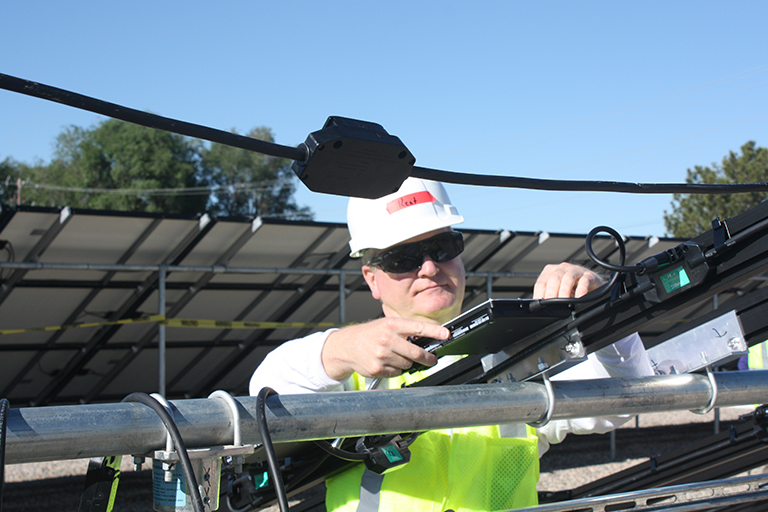By Kent Singer, CREA Executive Director
At total of 380 low-income electric coop members are enjoying the benefits of solar power this winter, thanks to Colorado’s electric co-ops, a nonprofit called GRID Alternatives and the Colorado Energy Office.
These three entities collaborated on several community solar gardens that specifically benefit income-challenged co-op members. With the 2017 completion of the last of these projects under a $1.2 million CEO grant, CEO released a comprehensive report that describes the details of the projects and the successful partnerships that made it all possible. All told, the community solar gardens expect to trim the electric bills of co-op consumers by $145,160 in the first year of the program and by more than $3 million over the life of the projects.
CREA Executive Director Kent Singer helps Grand Valley Power install solar panels that will help the co-op’s low-income members.
The community solar model in Colorado was initiated back in 2009 when United Power in Brighton introduced its Sol Power program. The first-of-its-kind program allows United’s customers to lease individual solar panels from large solar photovoltaic arrays and receive credit for the power generated from those panels. This arrangement allows utility customers who either cannot afford a large residential system or who live in condos or townhomes to take advantage of renewable energy without having to make a large capital investment or having to maintain the system. The larger arrays are also more cost effective in general when compared to smaller arrays installed on homes.
Community solar in Colorado got another boost in 2010 when a company called Clean Energy Collective partnered with Holy Cross Energy (Glenwood Springs) in the Roaring Fork Valley to establish its first community solar project near El Jebel. That 340-panel project was quickly fully subscribed, and Holy Cross and Clean Energy Collective added another 1-megawatt project at the Garfield County Airport a few years later. Clean Energy Collective has now built dozens of community solar projects across the United States.
In 2015, Grand Valley Power (Grand Junction) continued the community solar movement, but with a new approach. Grand Valley worked with GRID Alternatives, a nonprofit focused on providing solar power to low-income utility consumers to help ease the burden of their energy bills. Grand Valley was the first co-op in the country to identify customers who needed a hand paying their utility bills and to allow those customers to offset their energy usage with power generated from centrally-located solar arrays. This community solar model provides a short-term “hand up” to those who need it, and it allows more co-op member-owners to benefit from the solar installation.
After the successful Grand Valley Power program, GRID Alternatives received a grant of $1.2 million from CEO to launch the “Demonstration Project.” The project included additional community solar gardens at six more electric co-ops: Delta-Montrose Electric Association in Montrose, Empire Electric Association in Cortez, Holy Cross Energy in Glenwood Springs, Poudre Valley Rural Electric Association in Fort Collins, San Miguel Power Association in Ridgway and Yampa Valley Electric Association in Steamboat Springs. Over the last two years, these co-ops worked with GRID Alternatives and CEO to install nearly 1.5 MW of solar capacity in 19 different counties in Colorado. These projects have allowed low-income co-op consumers to get a break on their utility bills, and they have helped integrate more renewable energy into rural areas.
But while the benefit for co-op customers is clear, why would electric co-ops voluntarily sign up for a program that results in fewer sales of the one product they sell? Yes, it’s true that the community solar gardens helped the co-ops comply with their renewable energy requirements under state law and their individual co-op targets. It’s also true that the projects enabled the co-ops to get more hands-on experience with solar power and they helped co-ops diversify their power supply.
But the main reason co-ops got involved in this project is the fact that co-ops are nonprofit, member-owned electric utilities. They don’t have an incentive to make money for shareholders such as insurance companies or hedge funds. Co-ops are in this business to provide members with the most affordable, reliable and environmentally-sustainable power possible, but we’re also in it to serve our communities. In some cases that means trying to find creative ways to support those who are having a hard time paying their power bills. The CEO-GRID Alternatives program increased the accessibility of solar to more than just the co-op members in middle to upper income households.
Diane Johnson, CEO of Yampa Valley Electric Association, summed up the program: “YVEA is proud to help develop a renewable project that touches so many people. We expect that many ‘right’ answers exist for the future of energy, and we expect to embrace varied and innovative fuel choices.”
These new community solar gardens that focus on a specific set of members are just one of those choices.

